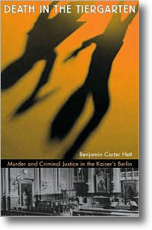| Benjamin Hett (212) 772 4382 | bhett@hunter.cuny.edu |
| CV |
|
|
Benjamin Hett Professor of History Hunter College ---
|
Research
Until recently my research has focused on the intersections of law, politics, and popular media in twentieth-century Germany. I am now shifting more into certain aspects of the Second World War and their legacies. My first book, Death in the Tiergarten: Murder and Criminal Justice in the Kaiser's Berlin (Harvard UP, 2004) dealt with what I call the "courtroom culture" of Berlin in the years between 1891 and 1914. The book looked at a number of criminal trials and examined how lawyers, judges, prosecutors, defendants, witnesses, politicians, and the press understood themselves and what they were doing in the criminal court. By studying changes in practice and outcomes over time, I argued that a significant liberalization was underway in the courts and the broader culture well before the outbreak of war in 1914. My second book, Crossing Hitler: The Man Who Put the Nazis on the Witness Stand (Oxford UP, 2008), was a biography of the Weimar-era German trial lawyer Hans Litten (1903-1938), who became famous through his devastating 1931 cross-examination of Adolf Hitler. Through a study of LItten and his career, as well as Litten's subsequent fate in the concentration camps of the Third Reich, I argued that the justice system of late Weimar was neither as judge-driven nor as consistently hostile to the political center and left as previous accounts have made out. In fact the very strenght of the rule of law before 1933 explains the gradual rather than sudden corruption of it under the Nazis. My third book, Burning the Reichstag: An Investigation into the Third Reich's Enduring Mystery (Oxford UP), appeared early in 2014. The Reichstag Fire was the moment at which Hitler and the Nazis were able to consolidate their power and move from a still-shaky coalition government to something approaching absolute power. Ever since 1933 an often very bitter controversy has raged over the question of "who did it" — did the Nazis themselves set the fire, to create a pretext for draconian legislation, or did the Lee Harvey Oswald-esquw, three-quarters blind and half-mad Dutch anarcho-Communist Marinus van der Lubbe act alone? I became interested in this subject in the latter stages of my work on Hans Litten. Litten was arrested the night of the Reichstag Fire, ans I spent some time trying to pin down the paper trail of his arrest. Most people simply assume he was arrested because he had drawn Hitler's hatred, but I wanted to see the evidence. This research led me into the controversy over when the arrest lists used that night were drafted. I began to be interested in the larger debate over the Reichstag Fire and its serious implications for understanding how and why the Nazis came to power — and the implications of the controversy itself for helping to understand how Germans "came to terms with the past" from the 1940s to the 1960s. In the course of doing this research I had the opportunity to see a number of sources to which historians of this subject had not previously been able to gain access. The book will bring out some new evidence about the fire itself, but perhaps more importantly, some new and rather shocking information about the nature of the controversy in the 1950s and 1960s. It is as much a meditation on how our history gets written — the mix of politics and interests that shape even academic research — as it is about the events of the fire itself. Current Project: The Strange Case of Otto John This project is about a real-life John le Carré story from the 1950s. In 1954 Otto John was the head of West Germany’s domestic intelligence service, the BfV. That July, while visiting West Berlin for commemorations of the 10th anniversary of the Valkyrie plot, he disappeared – and reappeared a few days later in East Berlin, where he gave a press conference announcing that he had defected, and fiercely criticizing the West German government of Chancellor Konrad Adenauer. But in December 1955 John reappeared in West Berlin following a daring escape from his Soviet minders – and he now claimed that the Soviets had kidnapped him, and he had played along only to save his life. West German authorities did not believe him, and in 1956 John was convicted of treason and sentenced to four years in prison. He spent the rest of his long life trying, unsuccessfully, to clear his name. What was the truth? This book uses a mass of new materials, including newly available records from the East German Stasi, the BfV itself, and documents obtained through FOIA applications to the FBI and CIA, to put forward a solution to the Otto John mystery. His disappearance was rooted in much larger factors of German and Cold War politics. John had been actively involved in the anti-Hitler resistance, but in the early 1950s he found himself working in a government increasingly filled up with ex-Nazis who hated him – chief among them his bitter rival Reinhard Gehlen, a leading Nazi intelligence officer and in the 1950s the head of West Germany’s foreign intelligence service. Gehlen was actively conspiring against John, and John feared that Nazis would soon be back in power in West Germany. John’s story is very much an international one, and this project will emphasize the role that British and American governments and intelligence agencies played in the development of the West German state in general and its security services in particular. The newly released records of the CIA, FBI, and MI5, along with interviews conducted with some CIA veterans, are at the heart of the source base. People like FBI Director J. Edgar Hoover and CIA chief Allen Dulles are central to the story. This project started for me as a solo effort but it is now a joint project with Professor Michael Wala of the Ruhr University in Bochum, Germany. Collaborating with Michael Wala offers enormous advantages: Along with co-author Constantin Goschler, Michael has recently published an important new study of the BfV (Keine Neue Gestapo. Das Bundesamt für Verfassungsschutz und die NS-Vergangenheit, Rowohlt, 2015), which was written and researched with the full cooperation of the BfV, including full access to its internal records (along with access to other classified intelligence records including those of Germany’s foreign intelligence service, the BND). All the records which Michael was able to see for this project are now available to me as well for the Otto John project. Last summer, Rowohlt offered Michael and me a contract for a German edition of this book. We do not yet have a contract for an English edition. John’s story casts a fascinating new light on the early Cold War, the involvement of the US and other powers in the development of the Western alliance, and how the Cold War intersected with West Germany’s struggle to come to terms with its Nazi past.
|
|




